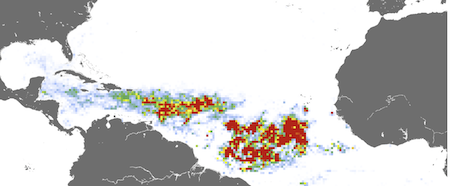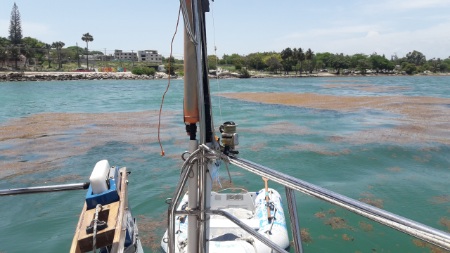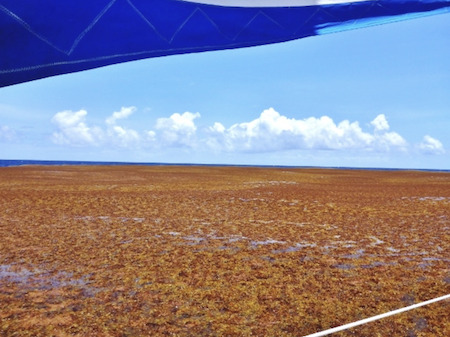North Atlantic: Record-breaking Sargassum Bloom
The carpet of Sargassum stretches over 5,000 miles, weighs over 10 million tons and creates havoc not only for those on land where it washes up, but also in the ocean, in anchorages and for sailors who encounter it on passage across the Atlantic.
Published 12 months ago
Scientists are saying that if you haven’t heard of the great Atlantic Sargassum Belt, chances are high that you’ll be hearing about it the northern hemisphere this summer.
The mass of seaweed looming in the Atlantic Ocean is now officially record-breaking according to the Sargassum Monitoring website. This is a new record for this time of year and after a decade of record-breaking blooms, 2023’s sargassum mass is again shaping up to cause headaches for beachside towns and tourists as well as sailors.
Maps on the Sargassum Monitoring website show reports from users all through the Caribbean – even through to Mexico and as far south as Guaxuma in Brazil.
Satellite monitoring
The Great Atlantic Sargassum Belt — the official name for the collection of floating brown seaweed that sprawls across 5,000 miles from the Gulf of Mexico to the west coast of Africa — contained about 13 million tons of seaweed by the end of March, according to researchers at the University of South Florida’s Optical Oceanography Lab who have been monitoring the sargassum belt via satellite.


The Sargassum quantity in March was mostly due to the large mass of weed in the central East Atlantic which was not a good sign as the peak months (June or July) for sargassum lie ahead, according to the University’s Sargassum Bulletin.
Visible from space, the Great Atlantic Sargassum Belt is believed to have some benefits, including serving as a habitat for certain fish and crustaceans and absorbing carbon dioxide.
But ocean currents are now pushing tonnes of the seaweed onto beaches, causing big problems where it can choke corals, wreak havoc on coastal ecosystems and diminish water and air quality as it rots.
Harmless to humans (almost)
The Sargassum Monitoring website says that while the sargassum itself is harmless to humans, it does harbor jellyfish, sea lice, and other stinging creatures that can irritate the skin — and the hydrogen sulfide it releases when it rots in the sun can aggravate breathing problems for people with pre-existing respiratory conditions, in addition to smelling like rotten eggs and making the beaches generally unpleasant for swimmers and sunbathers.
But it’s also an important habitat and food source for many sea creatures and poses no threat to human health when beach maintenance crews promptly remove it or use machines to cut it up and mix it into the sand.
Not good for beaches
Brian LaPointe, a research professor at Florida Atlantic University’s Harbour Branch Oceanographic Institute, told NBC: “It’s incredible. What we’re seeing in the satellite imagery does not bode well for a clean beach year.”
Mr LaPointe, who has studied Sargassum for four decades, said huge piles typically come ashore in South Florida in May, but beaches in Key West are already being inundated with algae.
Parts of Mexico’s Yucatan Peninsula, including Cancun, Playa del Carmen and Tulum, are already preparing for Sargassum build ups.
Navigation issues for boats
Brian Barnes, an assistant research professor at the University of South Florida said sargassum can “really threaten critical infrastructure.”
“Even if it’s just out in coastal waters, it can block intake valves for things like power plants or desalination plants, marinas can get completely inundated and boats can’t navigate through,” said Professor Barnes.


Implications for Sailors
The first mass sargassum bloom was seen in 2011, while the record bloom recorded in 2018 was ten times bigger.
Reports by participants in recent editions of World Cruising Club’s ARC TransAtlantic rally suggest that the weed can be a real nuisance on the crossing, snagging on spade rudders and bulb keels and creating drag.
For many skippers the first sign of weed was a drop in boat speed. While it could usually be shaken off with a few quick turns of the wheel, others had to dive to clear the propeller, or reverse their yacht to dislodge it.
Jörgen Wennberg was alerted to the problem by an alarming vibration as they sailed downwind on an Elan 410 during a previous ARC. “[Our] first check was the keel fitting on the inside. That looked solid, fixed to the hull. Next we looked at the rudder fitting to see if the vibrations came from the rudder stock – it looked OK. The next inspection was with a GoPro camera fitted on a long shaft. It was seaweed around the keel, propeller and rudder.
“We took the spinnaker down, turned upwind and let the boat drift backwards to release the seaweed from the boat. We did that seven times during our crossing.”
Others, like Stefan Morjak, turned to the engine to motor astern. “Our manoeuvre was full backward and forward in short intervals and the rudder fast changing from hard port to hard starboard. It’s a torture for engine and rudder but helpful.”


Detrimental effect
Sargassum also makes fishing impossible. Although sargassum provides a rich and important habitat for small fish, crabs and other marine life, which in turn attracts larger predator species, the oversized mats of weed can also have a detrimental effect, trapping marine creatures like turtles and suffocating coral.
Joint project to reduce sargassum impacts
In the Caribbean, five countries – Dominica, St. Lucia, St. Vincent and the Grenadines and Grenada – are participating in a project aimed at reducing the impacts of and improving adaptation to sargassum influxes in the Eastern Caribbean, with emphasis on transforming a climate-linked ecosystem hazard into an asset that supports opportunities for social economic development.
Find out more here at SargAdapt.
………………………
Related News:
- Huge Seaweed bloom can be seen from space (Skynews website)
- Sargassum Belt snakes around Florida (NPR website)
- Seaweed Mass Expands, Reaches Record Tonnage (Sargassum Monitoring)
- Why Sargassum poses a threat for Sailors (Yachting World)
- University of Southern Mississippi – Sargassum Threat
- University of the West Indies – Sargassum Outlook Bulletin
………………………
Related Noonsite Reports:
………………………
Related Links:
- Sargassum Monitoring – Twitter
- Sargassum Monitoring Website
- University of South Florida Optical Oceanography Laboratory
- Florida Atlantic University Harbor Branch Oceanographic Institute
- The University of the West Indies at Cave Hill, Barbados
………………………
Find out all news, reports, links and comments posted on Noonsite, plus cruising information from around the world, by subscribing to our FREE monthly newsletter. Go to https://www.noonsite.com/newsletter/.
Related to following destinations: Anse Mitan, Basse Terre, Bequia, Blue Lagoon, Cancun, Castries, Chateaubelair, Clarkes Court Bay, Corpus Christi, Deshaies, Dominica, East Coast (Mexico), Florida, Fort-de-France, Grenada, Grenville, Guadeloupe, Gulf Coast, Havre de la Trinite, Havre du Robert, Hog Island, Houston/Galveston, Iles des Saintes, Kingstown, Les Anses d'Arlet, Marie Galante, Marigot, Marigot Bay (St. Lucia), Marin, Martinique, Mero, Mexico, Mt Hartman Bay, Mustique, Ottley Hall, Petit Martinique, Pointe-a-Pitre, Port Egmont (Le Phare Bleu Bay), Port Louis (Guadeloupe), Portsmouth, Prickly Bay, Rodney Bay, Roseau, Saint Francois, Sauteurs, Soufriere, St Pierre (Martinique), St. Augustine, St. Davids, St. George's, St. Lucia, St. Vincent, St. Vincent & the Grenadines, The Grenadines, Trois Ilets, True Blue Bay, Tyrell Bay & Hillsborough (Carriacou), USA, Vieux Fort, Wallilabou Bay, Young Island Cut
Related to the following Cruising Resources: Atlantic and Caribbean, Atlantic Crossing, Atlantic Ocean West, Caribbean Sea, Circumnavigation, Environment, General, Rallies, Routing








